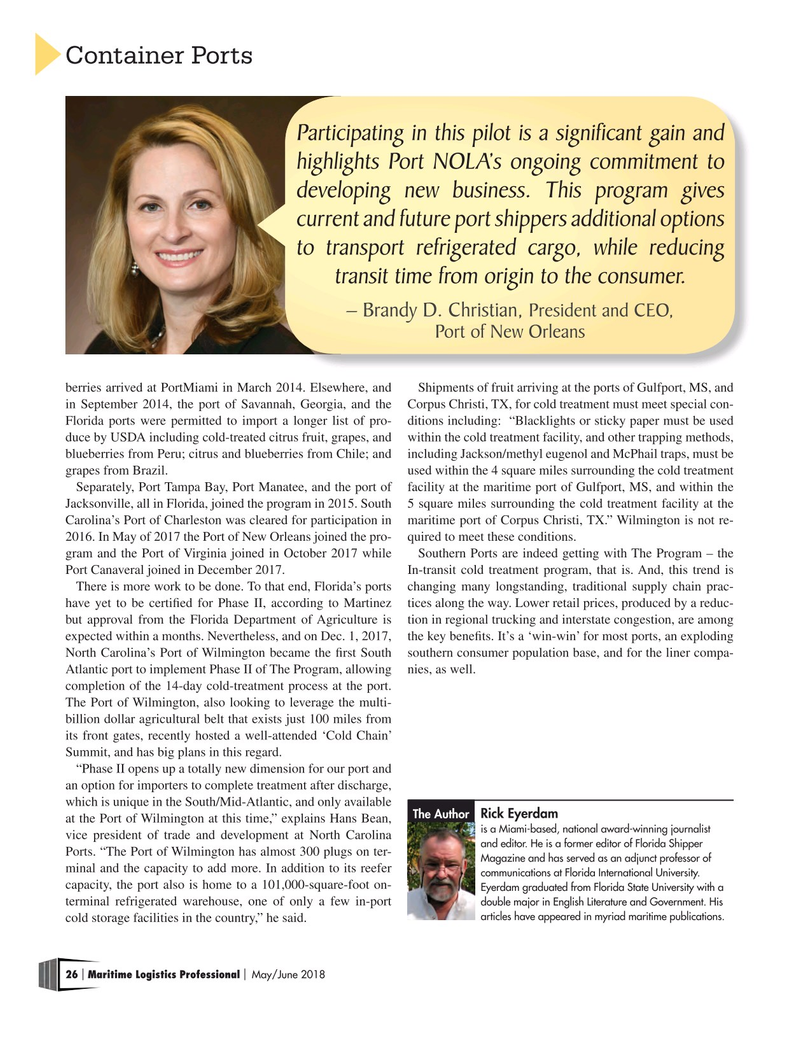
Page 26: of Maritime Logistics Professional Magazine (May/Jun 2018)
Container Ports
Read this page in Pdf, Flash or Html5 edition of May/Jun 2018 Maritime Logistics Professional Magazine
Container Ports
Participating in this pilot is a signifcant gain and highlights Port NOLA’s ongoing commitment to developing new business. This program gives current and future port shippers additional options to transport refrigerated cargo, while reducing transit time from origin to the consumer. – Brandy D. Christian, President and CEO,
Port of New Orleans berries arrived at PortMiami in March 2014. Elsewhere, and Shipments of fruit arriving at the ports of Gulfport, MS, and in September 2014, the port of Savannah, Georgia, and the Corpus Christi, TX, for cold treatment must meet special con-
Florida ports were permitted to import a longer list of pro- ditions including: “Blacklights or sticky paper must be used duce by USDA including cold-treated citrus fruit, grapes, and within the cold treatment facility, and other trapping methods, blueberries from Peru; citrus and blueberries from Chile; and including Jackson/methyl eugenol and McPhail traps, must be grapes from Brazil. used within the 4 square miles surrounding the cold treatment
Separately, Port Tampa Bay, Port Manatee, and the port of facility at the maritime port of Gulfport, MS, and within the
Jacksonville, all in Florida, joined the program in 2015. South 5 square miles surrounding the cold treatment facility at the
Carolina’s Port of Charleston was cleared for participation in maritime port of Corpus Christi, TX.” Wilmington is not re- 2016. In May of 2017 the Port of New Orleans joined the pro- quired to meet these conditions.
gram and the Port of Virginia joined in October 2017 while Southern Ports are indeed getting with The Program – the
Port Canaveral joined in December 2017. In-transit cold treatment program, that is. And, this trend is
There is more work to be done. To that end, Florida’s ports changing many longstanding, traditional supply chain prac- have yet to be certifed for Phase II, according to Martinez tices along the way. Lower retail prices, produced by a reduc- but approval from the Florida Department of Agriculture is tion in regional trucking and interstate congestion, are among expected within a months. Nevertheless, and on Dec. 1, 2017, the key benefts. It’s a ‘win-win’ for most ports, an exploding
North Carolina’s Port of Wilmington became the frst South southern consumer population base, and for the liner compa-
Atlantic port to implement Phase II of The Program, allowing nies, as well. completion of the 14-day cold-treatment process at the port.
The Port of Wilmington, also looking to leverage the multi- billion dollar agricultural belt that exists just 100 miles from its front gates, recently hosted a well-attended ‘Cold Chain’
Summit, and has big plans in this regard. “Phase II opens up a totally new dimension for our port and an option for importers to complete treatment after discharge, which is unique in the South/Mid-Atlantic, and only available
Rick Eyerdam
The Author at the Port of Wilmington at this time,” explains Hans Bean, is a Miami-based, national award-winning journalist vice president of trade and development at North Carolina and editor. He is a former editor of Florida Shipper
Ports. “The Port of Wilmington has almost 300 plugs on ter-
Magazine and has served as an adjunct professor of minal and the capacity to add more. In addition to its reefer communications at Florida International University. capacity, the port also is home to a 101,000-square-foot on-
Eyerdam graduated from Florida State University with a terminal refrigerated warehouse, one of only a few in-port double major in English Literature and Government. His articles have appeared in myriad maritime publications. cold storage facilities in the country,” he said.
26 Maritime Logistics Professional May/June 2018 | |

 25
25

 27
27
